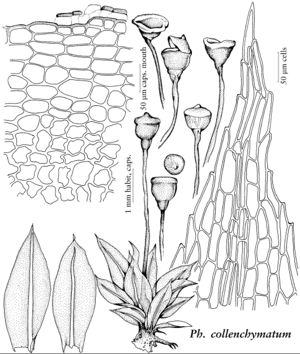Physcomitrium
Bryol. Univ. 2: 815. 1827 ,.
| Taxon | Illustrator ⠉ | |
|---|---|---|
 | Physcomitrium collenchymatum | Patricia M. Eckel |
Plants small, scattered to gregarious. Stems 2–10 (–25) mm, erect, simple or forked. Leaves crispate to contorted when dry, erect to spreading when moist, ovatelanceolate, ovate, to obovate, sometimes concave and cucullate, 1.2–5 mm; margins entire to serrulate distally; apices somewhat blunt, or acute to acuminate; costa single, subpercurrent to short-excurrent; proximal laminal cells elongate-rectangular to rectangular, distal cells rectangular to hexagonal. Sexual condition autoicous, occasionally polygamous; perigonia at apices of short basal or lateral branches, usually with clavate paraphyses; perichaetia at stem apex, with a few filiform paraphyses. Seta erect, 0.5–13 (–30) mm. Capsule stegocarpous, erect, immersed to exserted, symmetric, ovoid, globose, pyriform, or campanulate, often urceolate when dry, mouth sometimes flaring, 0.8–3 mm, smooth, neck usually wrinkled when dry; exothecial cells irregularly isodiametric, hexagonal, or oblong, sometimes collenchymatous; a few stomates usually present in neck, superficial; annulus narrow, consisting of 1–2 rows of small cells or revoluble as fragments of large cells; operculum convex to conic, apiculate to rostrate; peristome absent. Calyptra mitrate, deeply split into (2–) 3 (–4) spreading lobes, long-rostrate, sometimes inflated at the base, usually large, smooth. Spores spherical to subreniform, papillose to spinulose.
Distribution
Temperate North America, Mexico, Central America, South America, Europe, Asia, Africa, Australia
Discussion
Physcomitrium is characterized by erect, symmetrical, and often urn-like capsules that lack peristomes. Infra-species variation of both the sporophyte and gametophyte of Physcomitrium pyriforme has led to many species being described over time in North America.
Species ca. 80 (4 in the flora).
Physcomitrium commonly occurs on exposed soil often associated with spring-wet sites, often on alluvial mud and river banks, from near sea level to ca. 2500 m, and the capsules mature over winter into spring.
Selected References
None.
Lower Taxa
Key
| 1 | Capsules immersed. | Physcomitrium immersum |
| 1 | Capsules emergent to exserted | > 2 |
| 2 | Leaves entire, rarely with somewhat uneven margins distally; annulus revoluble, composed of large, inflated, mostly deciduous cells. | Physcomitrium hookeri |
| 2 | Leaves often toothed distally; annulus of small, non-inflated, adherent cells | > 3 |
| 3 | Plants 2-4(-5) mm; leaves to 2 mm long; seta 2-3 mm; capsules often shallow and wide-mouthed when dry; suboral cells weakly differentiated, usually consisting of 2-6 rows of irregularly isodiametric cells, spores less than 40 µm. | Physcomitrium collenchymatum |
| 3 | Plants commonly 3-10 mm; leaves usually to 2-5 mm; seta mostly 4-14 mm; capsules deeper, rarely wide-mouthed when dry; suboral cells strongly differentiated, consisting of 7-12 rows of transverse-elongate cells, spores typically greater than 40 µm. | Physcomitrium pyriforme |